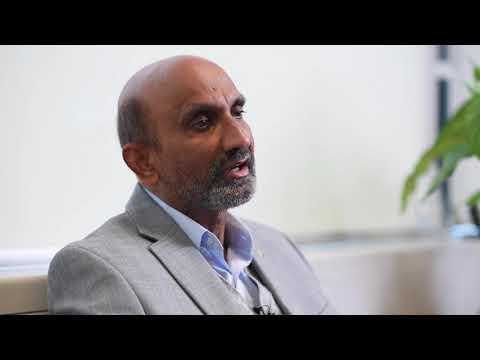Chennupati Jagadish AC
Use of brain organoids and artificial intelligence for understanding dementia

Award
Dementia Australia Research Foundation – Yulgilbar Innovation Grant
Status
Completed
Start Date
1 May 2019
About the project
This project presented a novel strategy for diagnosis and treatment of Alzheimer’s disease using an innovative approach that combined technologies in stem cell research with artificial intelligence (AI). The stem cell component of this project saw the development of ‘brain organoids’ or ‘mini-brains’ from stem cells taken from people living with Alzheimer’s disease as well as individuals unaffected by the disease.
The stem cell derived brain organoids were used to model brain function ‘in-the-dish’. Major findings from this research were 1) the identification of differences between Alzheimer’s disease and non-diseased neurons, and how alterations affect the communication between brain neurons, 2) new insights into how microglia, the brain’s immune cells, function in Alzheimer’s disease and 3) development of innovative bioengineering technologies to measure how neurons generated from stem cells and cultured in a dish can form networks and send signals to each other, which somewhat mimics brain connectivity. This novel project has contributed to a greater understanding of Alzheimer's disease.

Publications and presentations resulting from award
Transgene and chemical transdifferentiation of somatic cells for rapid and efficient neurological disease cell models”, Frontiers in Cellular Neuroscience 2022 Ng N, Maksour S, Newbery M, Dottori M, Sluyter R, Ooi L doi: 10.3389/fncel.2022.858432
Adhikari UK, Sakiz E, Habiba U, Mikhael M, Senesi M, David MA, Guillemin GJ, Ooi L, Karl T, Collins S, Tayebi M. 2021 Treatment of Microglia with Anti-PrP Monoclonal Antibodies Induces Neuronal Apoptosis In Vitro Heliyon, 2021 e08644.
Wells C, Brennan S, Ooi L. 2021 The role of amyloid oligomers in neurodegenerative pathologies International Journal of Biological Macromolecules 181:582-604.
Muñoz SS, Garner B and Ooi L. 2021 Generation of APOE knock-down SK-N-SH human neuroblastoma cells using CRISPR/Cas9: A novel cellular model relevant to Alzheimer’s disease research. Bioscience Reports 41 (2): BSR20204243. (journal cover image)
Ng N and Ooi L. 2021 A Simple Microplate Assay for Reactive Oxygen Species Generation and Rapid Cellular Protein Normalization. Bio-protocol 11(1): e3877 doi: 10.21769/BioProtoc.3877
Muñoz SS, Engel M, Balez R, Do-Ha D, Cabral-da-Silva MC, Hernández D, Berg T, Fifita JA, Grima N, Yang S, Blair IP, Nicholson G, Cook AL, Hewitt AW, Pébay A, Ooi L. 2020 A simple differentiation protocol for generation of induced pluripotent stem cell-derived basal forebrain-like cholinergic neurons for Alzheimer’s disease and frontotemporal dementia disease modeling. Cells. Sep 2;9(9):E2018.
Ooi L Dottori M, Cook AL, Engel M, Gautam V, Grubman A, Hernández D, King AE, Maksour S, Targa Dias Anastacio H, Balez R, Pébay, A, Pouton C, Valenzuela M, White, A, Williamson R 2020. If human brain organoids are the answer to understanding dementia, what are the questions? The Neuroscientist 26 (5-6):438-454.
Konttinen H, Cabral-da-Silva MC, Ohtonen S, Wojciechowski S, Shakirzyanova A, Caligola S,Giugno R, Ishchenko Y, Hernández D, Fazaludeen M, Eamen S, Gómez Budia M, Fagerlund I, Scoyni F, Korhonen P, Huber N, Haapasalo A, Hewitt AW, Vickers J, Smith G, Oksanen M, Graff C, Kanninen K, Lehtonen S, Propson N, Schwartz MP, Pébay A, Koistinaho J, Ooi L, Tarja Malm. PSEN1ΔE9, APPswe and APOE4 confer disparate phenotypes in human iPSC-derived microglia. Stem Cell Reports 2019 Oct 8;13(4):669-683.
Muñoz SS, Garner B, Ooi L. Understanding the role of apoE fragments in Alzheimer’s disease. Neurochemical Research, 2019 44(6), 1297-1305.
Fagerlund I, Dougalis A, Shakirzyanova A, Gómez-Budia M, Pelkonen A, Konttinen H, Ohtonen S, Feroze F, Koskuvi M, Kuusisto J, Hernández D, Pébay A, Koistinaho J, Rauramaa T, Lehtonen S, Korhonen P, Malm T. Microglia-like Cells Promote Neuronal Functions in Cerebral Organoids (2022). Cells 11: 124
Hernández D, Morgan Schlicht S, Daniszewski M, Karch CM, Dominantly Inherited Alzheimer Network (DIAN), Goate AM, Pébay A (2021). Generation of a gene-corrected human isogenic iPSC line from an Alzheimer’s disease iPSC line carrying the London mutation in APP (V717I). Stem Cell Research 53: 102373
Hernández D, Rooney LA, Daniszewski M, Gulluyan L, Liang HH, Cook AL, Hewitt AW, Pébay A (2021). Investigating the role of APOE: limitations of human pluripotent stem cell-derived cerebral organoids. Stem Cell Reviews and Reports in press (11th/29 cell & tissue engineering journals)
Konttinen H, Castro Cabral-da-Silva M, Ohtonen S, Wojciechowski S, Shakirzyanova A, Caligola S, Giugno R, Ishchenko Y, Hernández D, Fazaludeen MF, Eamen S, Gómez Budia M, Fagerlund I, Scoyni F, Korhonen P, Huber N, Haapasalo A, Hewitt AW, Vickers J, Smith GC, Oksanen M, Graff C, Kanninen KM, Lehtonen S, Propson N, Schwartz MP, Pébay A, Koistinaho J, Ooi L, Malm T. PSEN1ΔE9, APPswe and APOE4 confer disparate phenotypes in human iPSC-derived microglia. Stem Cell Reports 13:1-15.
Malepathirana T, Damith Senanayake, Gautam V, Ooi L, Jagadish C, Halgamuge S. et al., “An Incrementally Learned Visualization Framework for Longitudinal Multi-Electrode-Array Experiments “ [Journal Paper Draft Manuscript, Pre-submission approved by Nature Methods], 2022
Grubman, A., Choo, X.Y., Chew, G. et al. Transcriptional signature in microglia associated with Aβ plaque phagocytosis. Nat Commun 12, 3015 (2021). doi:10.1038/s41467-021-23111-1
Grubman A, Vandekolk TH, Schröder J et al. A CX3CR1 Reporter hESC Line Facilitates Integrative Analysis of In-Vitro-Derived Microglia and Improved Microglia Identity upon Neuron-Glia Co-culture. Stem Cell Reports. 2020 Jun 9;14(6):1018-1032. doi: 10.1016/j.stemcr.2020.04.007.
Leinenga G, Bodea LG, Schröder J, Sun G, Zhou Y, Song J, Grubman A, Polo JM, Götz J. Transcriptional signature in microglia isolated from an Alzheimer's disease mouse model treated with scanning ultrasound. Bioeng Transl Med. 2022 May 14;8(1):e10329. doi: 10.1002/btm2.10329
Raj V., Jagadish C., and Gautam V, “Understanding, engineering, and modulating the growth of neural networks: An interdisciplinary approach”, Biophysics Rev. 2, 021303 (2021) doi:10.1063/5.0043014.
Raj V, Gopakumar A, Vaidya G, et al. High-Density Individually Addressable Platinum Nanoelectrodes for Neuroscience Applications. Research Square; Discover Materials 2 (1), 6, 2022, doi: 10.21203/rs.3.rs-1528884/v1
Greenough MA, Lane DJR, Balez R, Targa H, Anastacio D, Zeng Z, Ganio K, McDevitt CA, Acevedo K, Belaidi AA, Koistinaho J, Ooi L, Ayton S*, Bush AI* (co-corresponding author). Selective ferroptosis vulnerability due to familial Alzheimer’s disease presenilin mutations. Cell Death and Differentiation. 2022; 29(11):2123-2136 doi:10.1038/s41418-022-01003-1
Where are they now?
At the time of award, Professor Jagadish was a Distinguished Professor and Head of Semiconductor Optoelectronics and Nanotechnology Group in the Department of Electronic Material Engineering, Research School of Physics and Engineering, the Australian National University. He is also serving as Director of Australian National Fabrication Facility, ACT node and Convenor of the Australian Nanotechnology Network.
